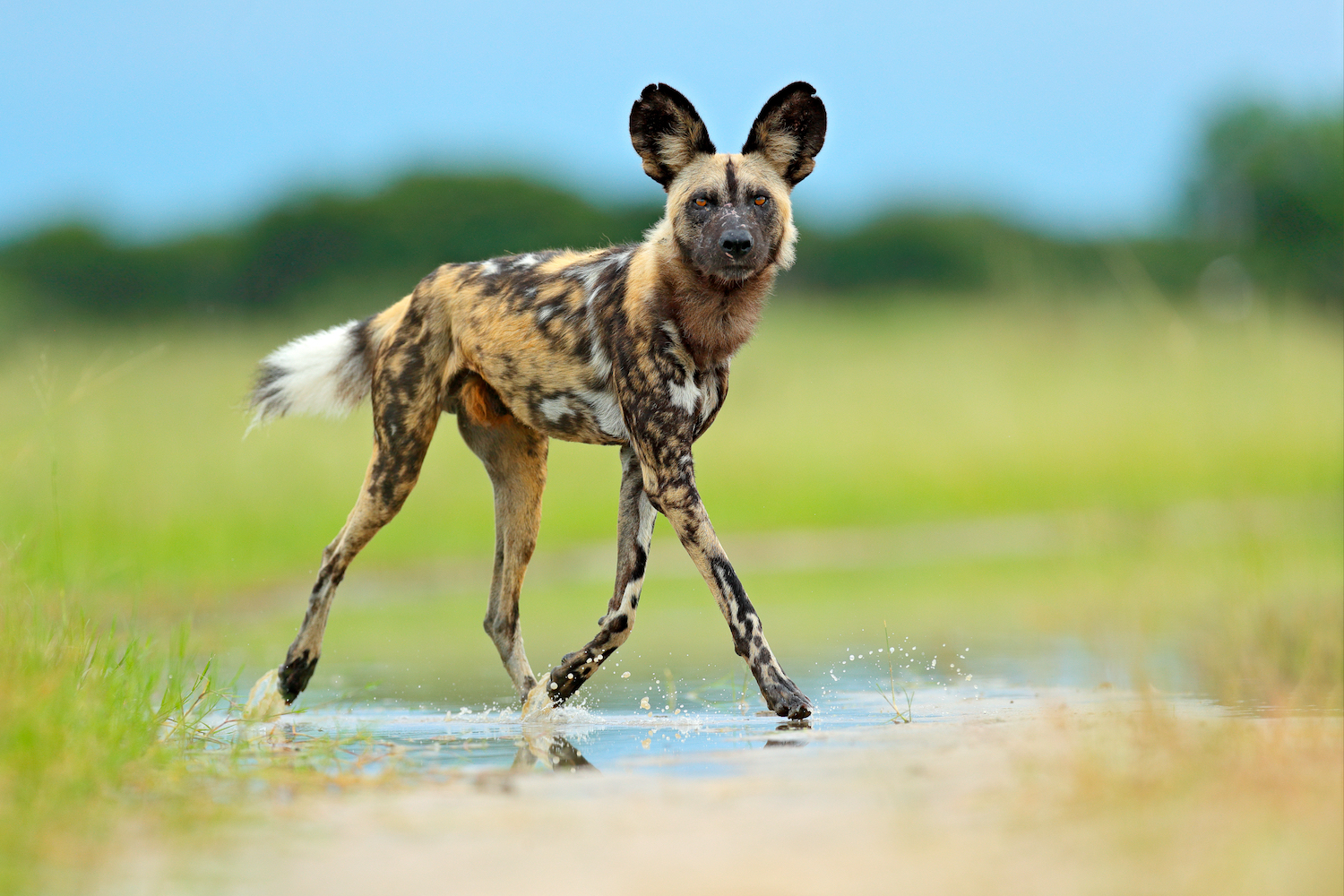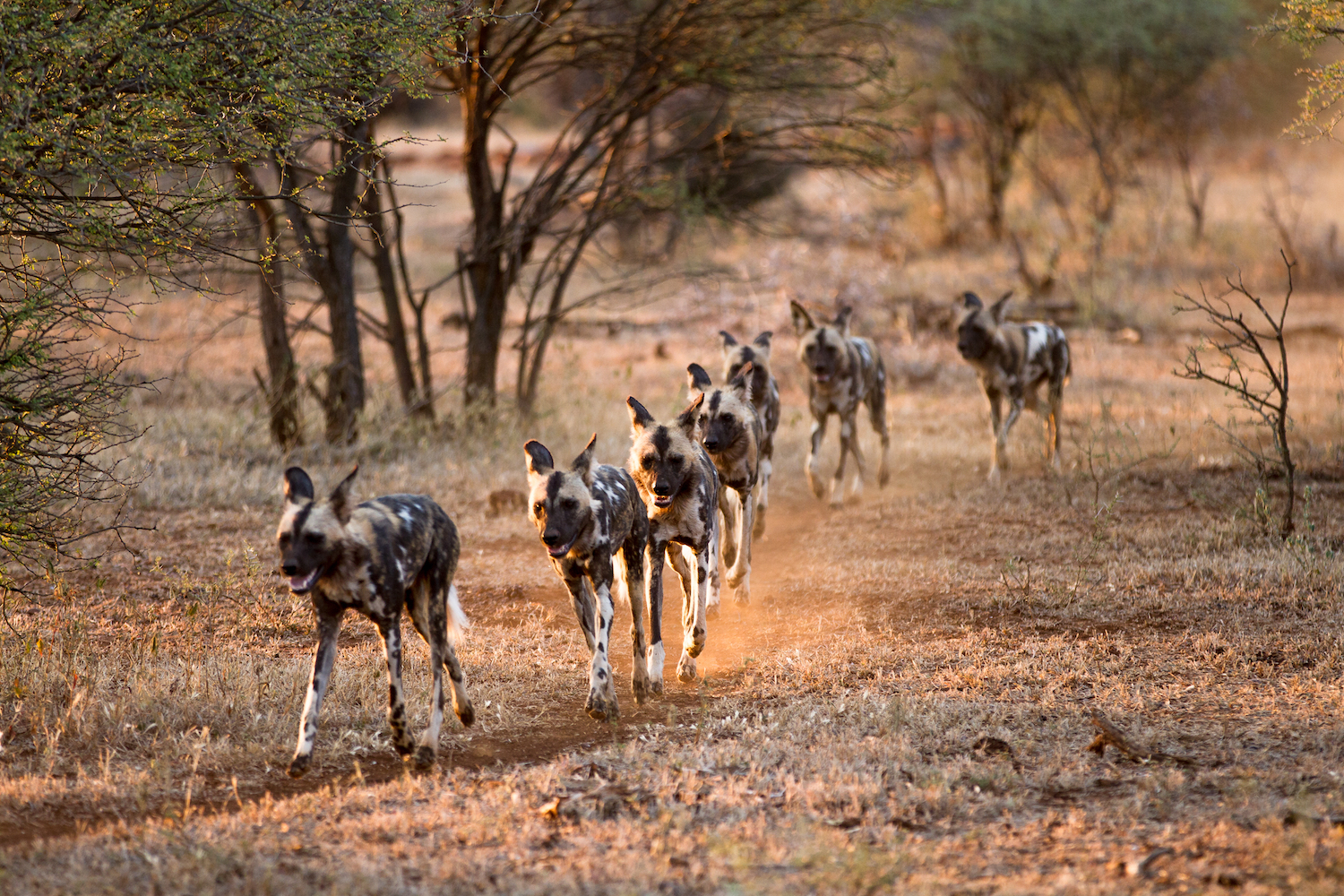Painted Wolves: The Colorful Carnivores of the African Wild

African wild dogs, Cape hunting dogs, painted dogs and painted wolves — despite their many names, this elusive species is not well-known outside of Africa. But these charismatic carnivores with a "Three Musketeers" attitude are unique and, to many, endangered painted wolf populations are worth saving.
A painter's palette
Though members of the biological Canidae family, painted wolves (Lycaon pictus, which translates to "painted wolf-like animal") are neither dogs nor wolves. Instead, they are the only living species of a distant evolutionary branch that's distinct enough that painted wolves can't breed with dogs or wolves.
The painted wolves' mottled coats have splashes of brown, black, white and yellow, and the color pattern is different for every individual, according to National Geographic. The long-legged mammals stand between 30 and 43 inches (76 and 109 centimeters) tall and weigh from 40 to 79 lbs. (18 to 36 kilograms) as adults. Another distinguishing feature is their large round ears that help them pick up the faintest rustlings in the bush.
As carnivores distributed across sub-Saharan Africa, painted wolves must follow their source of food, which can require traveling great distances. Their main choice of prey is medium-size antelope like impalas, but they are known to take down larger animals on the rare occasion and supplement their diet with rodents and birds between main kills. Even baboons are subject to the painted wolves' highly efficient pack-hunting strategy that has an estimated success rate of 80 percent or more.
All for one, one for all
To achieve that hunting success, painted wolves work cooperatively as a pack, commonly with five to 15 members; though the larger the pack, the more efficient it is. Each pack generally has an alpha female and an alpha male, and this monogamous pair is the only one breeding. The pack members communicate through actions, including gestures and physical touching, and vocalizations, such as chirps, twitters and grunts. A recent study discovered that individuals can vote on group decisions through sneezing.
The pack is very family-orientated and has strong bonds. "Their social structure is just fascinating," said Brandon Davis, co-founder of the Painted Dog Protection Initiative. "It's more akin to a bee or ant colony."
Davis said the pack attitude reminds him of the motto of the Three Musketeers: all for one and one for all. Each member has its own role, but they are all equal in the pack. In addition to caring for the young, the pack looks after its elder and injured members. The group might give a slow individual or poor hunter the role of babysitter, rather than kick that individual out.
Get the world’s most fascinating discoveries delivered straight to your inbox.
The alpha female can birth from two to 20 pups in a litter. Those pups are at the top of the pecking order after hunts. If the food is too far or unsafe for the pups to reach, older pack members will gorge themselves and regurgitate it up for the pups. While the pups' first pick of the meal boosts pup survival rate, it can hurt the survival of the nonbreeding adults, as discovered in a 2015 study published in the journal Behavioral Ecology. As the pack size and number of offspring increases, hunting efforts might not sustain all members, and malnourished adults may die for the sake of the pups.
Ensnaring threats
This pack-size dynamic, however, is not the largest danger to the species, which is the second most endangered canid on the continent after the Ethiopian wolf. In 2012, the estimated painted wolf population was around 6,700 individuals, including 1,400 mature, or capable of reproducing, adults, according to an International Union for Conservation of Nature (IUCN) report.
The biggest threat to the painted wolf population is the fragmentation of this nomadic creature's habitat. Their wide ranges can take them outside of protected reserves and into areas frequented by people. There, painted wolves face new obstacles, such as roads where vehicles can hit them and farms where farmers may kill them out of fear that the painted wolves will kill livestock. In addition, proximity to domestic dogs means the painted wolves could catch the dogs' infectious diseases.
Even the painted wolves' natural threats are heightened with increased habitat fragmentation. Lions will prey on them, especially the pups, and hyenas will steal their kills. Painted wolves are most vulnerable to these natural threats during their three-month denning periods, when the pack stays close to a den until the pups are big enough to travel distances. As the resources shrink, the territories of lions, hyenas and painted wolves will overlap more.
All these causes of decline are linked to human encroachment on painted wolf habitat, according to the IUCN report, "and, as such, have not ceased and are unlikely to be reversible across the majority of the species' historical range."
One area where some conservationists hope to reverse the trend is accidental death by snares. People set wire snares in the bush, usually to catch antelope, Davis said. Trappers might hide between five and seven snares in one area. As the painted wolves chase antelope through the bush, one painted wolf might be caught by a snare. Given the mentality of the pack, other members will come back to help that individual and often end up caught by other snares. "The whole pack can get wiped out easily," Davis said. "It can be devastating."
Davis and his team at the Painted Dog Protection Initiative have been designing anti-snare collars. They partner with organizations that have experience putting tracking collars on painted wolves. The collars have hardware designed to catch and direct the snare down onto the collar. That way, the trapped animal won't strangle or severely injure itself. It still must struggle against the wire to break it free, but the collar gives it "a chance of surviving," Davis said.
Davis and his colleagues are working to reverse the harmful effects of humans on painted wolves, he said, by "giving them a leg up."
Additional resources:
- For more photos, check out this slideshow on the packs featured in BBC America's "Dynasties" series.
- To see how the anti-snare collars work, watch the collar-testing video from the Painted Dog Protection Initiative.
- Learn more about painted wolves from the Painted Wolf Foundation.





